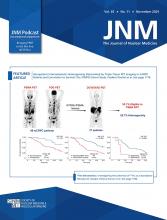I am a cancer survivor, 2 different kinds—prostate cancer and metastatic melanoma. The reason I am a survivor is that I received patient-individualized therapies, administered by an excellent staff (Tri-Cities Cancer Center, Kennewick, WA). Many of you know I am an outspoken advocate for the need for the nuclear medicine community to perform patient-individualized radiation dose calculations in nuclear medicine therapy applications. In 2008, I did a systematic evaluation of uncertainties in radiopharmaceutical dosimetry (1), concluded that any given estimate of radiation dose may have an uncertainty of a factor of between 2 and 5, and estimated that this could be reduced to about 10%–20% if patient data are used to develop doses for each patient. Then, I made “The Case” for patient-individualized dosimetry in nuclear medicine therapy (2) in a broad sense. I concluded that
“Treating all nuclear medicine patients with a single, uniform method of activity administration amounts to consciously choosing that these patients be treated with a lower standard of care than patients who receive radiation externally for cancer treatments.”
Many have expressed concern about this position, but I stand by my assessment. Logically, it is clear, but many nuclear medicine physicians think we are doing fine without any dosimetry. Therefore, most patients get the same therapy prescription, with no evaluation of organ and tumor uptake and clearance rates.
One radiopharmaceutical for which we did a form of personalized dosimetry was 131I-tositumomab (Bexxar; GlaxoSmithKline). Doses were estimated to the total body, and we assumed that the total-body dose was a decent surrogate for marrow dose, which was the normal tissue of concern. In 2005, Wahl (3) reported the results of over 1,000 non-Hodgkin lymphoma treatments with Bexxar. As shown below, there was a well-defined distribution of values of activity indicated to keep the marrow dose below 75 cGy. The mean was well characterized (∼80 mCi), but individual values varied by a factor of 3 to 5. Therefore, if we just gave 80 mCi to all patients, many patients would have been given too little activity and many would have received too much. For most therapeutic radiopharmaceuticals, a one-size-fits-all approach is generally used, and patients are simply receiving suboptimal treatments. This and other findings are detailed in Figures 1–4 (3–6).
Variability in patient treatments in non-Hodgkin lymphoma with Bexxar. (Reprinted from (3).)
First treatment efficacy in hyperthyroid therapy, with and without patient-individualized thyroid dosimetry. (Reprinted from (4).)
Stark difference in patient progression-free survival for patients whose tumor doses were above and below 200 cGy. If no tumor dosimetry is done, we cannot know what doses patients’ tumors are receiving, and thus what progression-free survival can be expected. (Reprinted from (5).)
Compared with standard dosimetry, personalized dosimetry significantly improved objective response rate in patients with locally advanced hepatocellular carcinoma. Results of this study suggest that personalized dosimetry is likely to improve outcomes in clinical practice and should be used in future trials of selective internal radiation therapy. (Reprinted from (6).)
Our cancer patients deserve the best medical treatment we can provide. In “The Case”, I showed that this is not very difficult; we have excellent dosimetry models that are well tested and proven, and the cost of performing patient-individualized dosimetry is generally much less expensive than the dosimetry we do every day for external beam dosimetry or about the same as the most elaborate methods. I spoke with a colleague in radiation oncology, and he agreed that if we stopped doing dosimetry for external beam radiation therapies, this would constitute medical malpractice!
I will always be eternally grateful to the two oncologists that provided me with excellent patient-individualized care. If I had been given the one-size-fits-all methodology, I am not sure I would have received such good outcomes. All of our patients deserve optimal radiation therapy plans. The “cost” alluded to in the title of this piece refers to the patients above and below the average of the Wahl distribution, who would have received suboptimal therapies and may not have had optimal outcomes. The Bexxar dosimetry was fairly simplistic, but at least we had an estimate of marrow dose for each patient. Join me in telling these wonderful people (our cancer patients) that we will begin optimizing their radiation therapies and treat them as well as we do our external beam therapy patients. The time has come for the Nuclear Medicine community to approach cancer therapy with the same individualized approach as does the Radiation Oncology community.
DISCLOSURE
No potential conflict of interest relevant to this article was reported.
Footnotes
Published online Aug. 14, 2024.
- © 2024 by the Society of Nuclear Medicine and Molecular Imaging.












